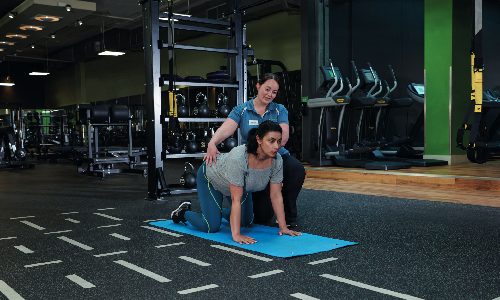Menopause and pelvic health: 5 unwelcome symptoms and 5 easy wins
Many of us are familiar with the more obvious symptoms that women may experience during this time of life, such as hot flushes, mood swings, insomnia, night sweats and weight changes. These are the kinds of things we might mention to our friends, partner or even our GP.
However there are a group of pelvic symptoms of menopause that are less well known, yet affect over 50% of women and can cause great discomfort and anxiety.
5 common pelvic symptoms of menopause
- Urinary incontinence – this includes urge incontinence (finding it hard to hold on when you need the loo and leaking before you get there) and stress incontinence (leakage when you cough, laugh, sneeze or trampoline with your grandkids!)
- Vaginal dryness/irritation – women can complain of vulval or vaginal soreness or dryness (particularly during foreplay and sex) or irritation around the vulva and urethra
- Frequent urinary or vaginal infections such as thrush and bacterial vaginosis – urinary tract infections are relatively common and often aren’t picked up on a midstream urine test, meaning you can go some time without receiving the correct treatment
- Pelvic pain – this can be felt in the vulva, vagina or deeper in the pelvis during sex, urination or at other times
- Pelvic organ prolapse – this is a condition whereby the pelvic organs move down with gravity and cause a vaginal lump or heavy feeling.
Why do these symptoms develop?
All of these symptoms are attributable to a reduction in oestrogen levels around the genital region as you reach peri-menopause.
The vulvovaginal tissues love oestrogen and just aren’t happy when they don’t get enough – becoming thinner, more easily inflamed and irritated (it’s like your garden pots going without water all summer!). This results in the urethra not being sealed in the same way, increasing the risk of infection.
The reduction in oestrogen also changes the pH of the vagina, which can also increase the risk of vaginal infections. The result of a dry, irritated genital region is often pain or discomfort – but it’s not something women always feel comfortable admitting.
Pelvic organ prolapse can become obvious with low oestrogen levels alongside a reduction in muscle mass of the pelvic floor muscles. Many women also suffer with constipation during the menopause – and straining on the toilet to empty your bowels can often worsen any existing prolapse.
5 ways to reduce pelvic symptoms of menopause
The good news is there are lots of things you can do to help if you’re experiencing any of these symptoms. Here are some easy wins.
1. Topical oestrogen and hormone replacement therapy (HRT)
Your GP can prescribe local oestrogen cream/pessaries for the vulvovaginal region, which can improve the elasticity and health of the tissues in the region. This can often reduce irritation and urinary tract infections, but may take up to 6 weeks to become effective. You may also like to talk to your GP about other HRT options.
2. Vaginal lubricants
There are several vaginal moisturisers and lubricants on the market that can offer short-term relief from vulvovaginal discomfort and improve comfort during sex. Make sure you use a silicone or hyaluronic lubricant regularly and for sexual intercourse to reduce any dryness.
3. Reduce irritation
Follow good vulvar skin care using skin cleansers (not soap) and consider a vulvar moisturiser with non-perfumed ingredients. If it irritates, don’t use it. Here are a few more ways to reduce irritation:
- Avoid removing pubic hair
- Avoid using intimate wipes
- Ensure your toilet paper and sanitary products don’t have added perfume or chemicals
- If you’re using a pad for leakage, use an incontinence pad, not a sanitary pad
- Ensure your washing powders/liquids and fabric conditioners are non-irritating
- Avoid wearing tight clothing and thongs, and wear breathable materials for athletic activities.
4. Stop smoking
Cigarette smoking affects your blood circulation, and may lessen the flow of blood and oxygen to the vagina and other nearby areas. Smoking also reduces the effects of naturally occurring oestrogens in your body. Speak to your GP or pharmacist about getting help and support to reduce or give up smoking.
5. Pelvic floor muscle exercises

Your pelvic floor is a group of muscles that sling underneath your pelvis and are responsible for controlling your bladder and bowels. They’re also involved in sexual pleasure and offer support to your entire pelvis. After the age of 40, we lose muscle bulk throughout our body, including the pelvic floor
The old adage ‘use it or lose it’ has some truth to it. Improving the strength and function of these muscles can reduce urinary symptoms, improve circulation to the genital region, reduce irritation, and may help or prevent symptoms of pelvic organ prolapse.
Here are some pelvic floor exercises you can try right now. It’s never too late to start – contrary to popular belief, these exercises aren’t just for women of childbearing age. Exercise classes such as yoga and Pilates can also help to strengthen the pelvic floor.
- If you're looking for a Pilates class to try out, give this 5-minute class a go:
Need more support?
If you’re struggling with any of these symptoms and would like some more guidance, speak to one of our pelvic health specialist physiotherapists. They can assist you with a range of pelvic conditions, as well as teach you to perform pelvic floor muscle exercises correctly.
And if you’re having difficulty coping with the symptoms emotionally, talking about it with people you trust, or a mental health specialist, can help.
For information, including downloadable leaflets, visit the following websites:
Last updated Thursday 4 May 2023
First published on Wednesday 13 October 2021

